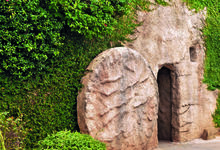Three days that changed the world
Good Friday to Easter — eventful days bursting with emotion. And full of active characters. Victims, culprits, observers—they all contribute to this extraordinary chapter in the history of God's salvation.

Jesus — the Suffering Servant: without Jesus Christ, this story would not exist. His suffering on Good Friday is harrowing, His resurrection on Easter leads the way to our own. He suffered under the dreadful torments of His impending death. The crown of thorns bloodied His face, the effort of carrying the cross after the many scourges He had received caused Him extraordinary pain and, to top it all off, nails were hammered into His palms. The Man Jesus had to endure all of this—suffering, derision, and torture—before He died. "And Jesus cried out with a loud voice, and breathed His last" (Mark 15: 37). But on Easter He celebrated His resurrection—and with Him His church!
Pontius Pilate — the mighty one: the governor of Judea and Samaria washed his hands in innocence. He was one who possessed power, a favourite of Rome, a man at the helm who gave orders and issued commands. He was not among the squeamish. Capable of generosity? Far from it. First Rome, then his own wallet, and only then everyone else. Later on, when he himself was accused, the charges against him were numerous: bribery, insult, theft, violence, lawlessness, executions without judicial process, cruelty. The Bible describes him in an ambivalent way: he did not seem to be truly convinced of Jesus' guilt. In the end, however, he bowed to the pressure of the people around him: "Then Pilate said to them, 'Why, what evil has He done?' But they cried out all the more, 'Crucify Him!'" (Mark 15: 14).
Barabbas — the foil: the robber and murderer who is freed. He was the foil to Jesus Christ. One of them was to be crucified: either he or Jesus of Nazareth. "Jesus or Barabbas?" — This question still rings in our thoughts and emotions. The people decided in favour of the criminal. The villain was freed: "So Pilate, wanting to gratify the crowd, released Barabbas to them; and he delivered Jesus, after he had scourged Him, to be crucified" (Mark 15: 15).
Simon of Cyrene — the coincidental bystander: Jesus collapsed as He carried His own cross. Simon happened to be nearby, and had just returned from working in the fields. The soldiers compelled him to pick up the cross that had fallen and carry it part of the way for the condemned Man Jesus. "Then they compelled a certain man, Simon a Cyrenian, the father of Alexander and Rufus, as he was coming out of the country and passing by, to bear His cross" (Mark 15:21).
The centurion — an admirer: there were many personages assembled under the cross of Jesus. Basically, they constitute a reflection of modern society: there were those who hesitated, those who were curious, those who were spiteful, those who wept, those who thought evil thoughts—and then there was the centurion, who observed the crucifixion of this unknown Man with what were apparently mixed emotions. Perhaps, as a soldier, he was not permitted to show his emotions, but in the end he nevertheless spoke clearly: "So when the centurion, who stood opposite Him, saw that He cried out like this and breathed His last, he said, 'Truly this Man was the Son of God!'"(Mark 15: 39).
Joseph of Arimathea — the secretive benefactor: was this Joseph one of Jesus' disciples or not? He never professed so openly, likely for fear of the people. However, after Jesus had been crucified, he went to Pilate to ask for the body of the deceased. The fact that this man was even able to approach the governor identifies him as a rich Jew. "Then he bought fine linen, took Him down, and wrapped him in the linen. And he laid Him in a tomb which had been hewn out of the rock, and rolled a stone against the door of the tomb" (Mark 15: 46).
Good Friday turns into Easter — death turns into life
Three days after Good Friday, Jesus resurrected, just as He had promised beforehand. We celebrate Easter as the feast of the resurrection.
Here it is the women who come to the fore: "Now when the Sabbath was past, Mary Magdalene, Mary the mother of James, and Salome bought spices, that they might come and anoint Him. Very early in the morning, on the first day of the week, they came to the tomb when the sun had risen. And they said among themselves, 'Who will roll away the stone from the door of the tomb for us?' But when they looked up, they saw that the stone had been rolled away—for it was very large. And entering the tomb, they saw a young man clothed in a long white robe sitting on the right side; and they were alarmed. But he said to them, 'Do not be alarmed. You seek Jesus of Nazareth, who was crucified. He is risen! He is not here" (Mark 16: 1-6).
Photo: ChristArt - Fotolia








